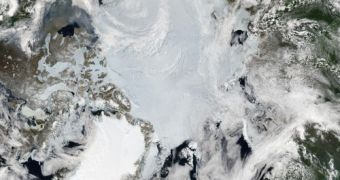Sporadic clouds over the Arctic in late June, allowed unfiltered sunlight to melt the ice and the snow. This phenomenon comes at the same time as the summer solstice, in an all-daylight period. Observations were made by the Moderate Resolution Imaging Spectroradiometer (MODIS) on NASA’s Aqua satellite, on June 28.
The image shows little cloud presence over the Arctic Circle. They appear over Northern and Western Scandinavia and between Alaska and the Russian Federation, but most of the Arctic is cloud-free. Greenland appears on the image too, covered in white snow.
In May and June temperatures were quite high and the ice melting started earlier than usual, over much of the Arctic. Snow and ice melting affect the albedo (the ratio of the outgoing solar radiation reflected by an object to the incoming solar radiation incident upon it) in two ways: it reduces sea ice surface and replaces most of the light-reflecting sea ice with light-absorbing seawater, and it also changes dry snow to wet snow. Wet snow is darker than dry snow and it absorbs three times the energy coming from the sun.
The Moderate Resolution Imaging Spectroradiometer is located aboard the Terra and Aqua satellites. Terra passes around the Earth from north to south across the equator in the morning, while Aqua goes south th north over the equator in the afternoon. These two satellites, view the entire surface of the Earth every 1 to 2 days and they gather data in 36 spectral bands (groups of wavelengths). MODIS contributes to developing a model that can predict global changes in an accurate way, so that correct environmental protection policies can be made.
Aqua, is a NASA Earth Science satellite mission that collects information about the Earth's water cycle, including evaporation from the oceans, water vapor in the atmosphere, clouds, precipitation, soil moisture, sea ice, land ice, and snow cover on the land and ice. It also measures radiative energy fluxes, aerosols, vegetation cover on the land, phytoplankton and dissolved organic matter in the oceans, and air, land, and water temperatures.

 14 DAY TRIAL //
14 DAY TRIAL //